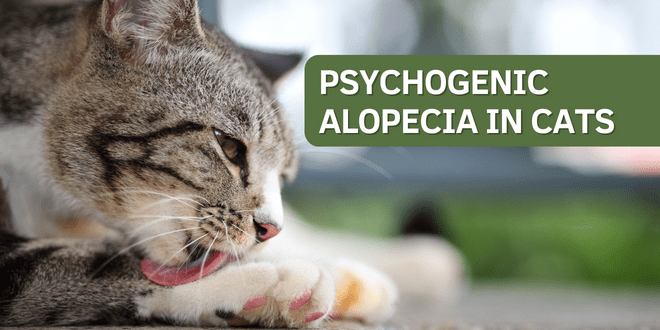
What is Psychogenic Alopecia?
This is a condition where the cat engages in excessive grooming that becomes an obsessive behavior. This goes beyond the normal fastidious grooming that a cat would exhibit.
Initially, psychogenic alopecia begins as a displacement behavior that the cat engages in to relieve stress. The over-grooming becomes something the cat can’t control and is the only way to stay calm. Any number of things can trigger a need to self-soothe through excessive grooming. With some cats, the excessive licking can eventually turn into actually pulling out clumps of hair or even chewing on the skin which can result in anything from irritation to actual open sores.
The cat may lick or chew any location on his body where he can reach but typical spots are the forelegs, inner thighs, back legs, sides, and abdomen.
The hair may initially look thin and dull, but then you may start to notice actual bald patches and wounds.
Any number of things could trigger the need for a displacement behavior but here’s a list of just a few possibilities:
The addition of another cat
Move to a new home
Renovation in the home
Addition of a new family member
Death or divorce
Living in a chaotic environment
Lack of environmental enrichment
Depression
Confinement (such as hospitalization or boarding)
Change in litter box set-up or conditions
When it comes to the stressors that could potentially lead to a need for a behavior such excessive grooming, keep in mind that it’s different for each cat. One cat may handle a major change in the environment while another cat may engage in self-directed trauma.
Understanding Displacement Behavior
A certain amount of displacement behavior is normal in a cat’s world. It helps reduce the anxiety that a cat is feeling in a particular situation. The problem occurs when there is no relief from that anxiety so the cat must continue the displacement behavior in order to self-soothe. Ongoing situations that produce anxiety without relief may lead the cat to require the displacement behavior to a point where it becomes obsessive and harmful.
Other Causes of Excessive Grooming
Before labeling the condition as psychogenic alopecia, it’s important to rule out other potential causes for excessive grooming such as:
Skin conditions
External parasites
Allergies
Cystitis or other urinary tract problem
Your cat must be seen by the veterinarian to rule out any potential underlying medical condition causing the behavior. In addition to diagnostic testing, clues to the cause of the behavior may be revealed based on where on the body the cat is licking. There is no actual test to determine psychogenic alopecia. Diagnosis is based on ruling out other causes, physical signs, and getting a behavioral history.
Treatment for Psychogenic Alopecia
There are three major components to helping a cat with psychogenic alopecia:
- Reduce stress
- Provide constructive ways to help the cat remain calm
- Increase environmental enrichment
Carefully evaluate your cat’s living conditions so you can identify the stressors. Keep in mind cats thrive best when there is predictability and routine, so if you’ve been inconsistent with the feeding schedule or less than diligent about litter box maintenance, that could be a source of anxiety. If your work schedule has changed or you’ve entered into a new relationship which causes your cat to be along for longer periods, that sudden change and increase solitary time could be the root of the problem. Was a new cat added to the family? Is your cat getting intimidated by other cats in the household? When it comes to stress reduction you need to be a detective and look at the situation from your cat’s point of view. Psychogenic alopecia is a stress-related disorder so something is causing stress overload in your cat’s life.
Multipet environments can wonderful and can provide tremendous companionship for cats but they can also be an ongoing source of stress and fear. If your cat shares the home with other pets, it’s time to look at the relationships and see whether there’s any tension or hostility. Perhaps the cat feels afraid to cross another cat’s preferred area in order to gain access to resources such as food or the litter box.
If you feel as if you have no clue as to the possible stressor(s), it may be helpful to set up a video camera. If you don’t already have a video security camera monitoring the inside of your home, you can pick up an inexpensive camera from Amazon that connects with your smartphone. Having video evidence may help you identify triggers. Through video evidence you may see that an outdoor cat comes around and that causes your cat to become frustrated and stressed, or maybe one cat housemate ambushes another routinely at the litter box or food bowl.
Environmental enrichment is an important aspect of feline life. Cats are predators and they were born to explore, hunt, and experience stimulation. Psychogenic alopecia may be the result of your cat simply having no outlet relieving stress or getting rid of stored-up energy. Set up puzzle feeders to keep your cat engaged during the day. Make sure there are adequate climbing opportunities in the form of a cat tree, cat shelving, or window perches. Rotate toys to prevent boredom and when you place them out, put them around the house in interesting ways for your cat to go on a treasure hunt.
Engage in interactive playtime on a regular basis (at least twice a day) to help provide exercise, fun, stress-relief, confidence building, and bonding time with you. This type of playtime allows your cat to totally enjoy being a hunter as you move the toy like prey. Frequent playtime is one of the most effective ways to redirect the cat’s attention and provide a constructive, healthy way to change unwanted behavior.
Pheromone therapy may also be useful as you incorporate environmental enrichment. Set up Feliway pheromone diffusers around the house. These alone will not solve the problem but they could be a valuable addition to the overall behavior plan.
Medication
If your cat doesn’t respond enough to the behavior plan, your veterinarian or veterinary behaviorist may recommend adding medication temporarily. Medication should be used in conjunction with behavior work though, so if it’s prescribed, don’t drop the ball when it comes to the hands-on responsibilities the human family members have to eliminate or at least significantly reduce stressors, and create a more cat-friendly environment.
Need More Information?
If your cat is exhibiting an excessive grooming behavior, or if you notice bald patches, increased hairballs, or the other signs mentioned in this article, consult with your veterinarian. Sometimes the cat parent doesn’t actually see the grooming behavior because the cat engages in it when alone. You may only notice the bald spots or you may notice behavioral changes such as hiding or lack of interaction with the family. ANY change should be viewed as a potential red flag, so speak with your veterinarian. Your veterinarian may provide you with a referral to a veterinary behaviorist or certified cat behavior consultant.
For more information on cat behavior and training, refer to the best-selling books by Pam Johnson-Bennett. Pam’s books are available at bookstores and online. We’ve included Amazon links here on our website.
If you have a question regarding your cat’s health, please contact your veterinarian. This article is not intended as a replacement for your cat’s veterinary care.




